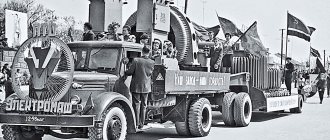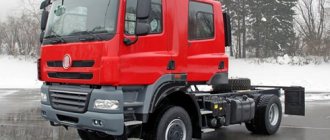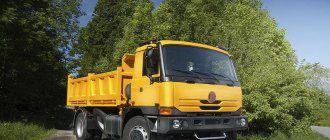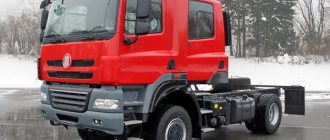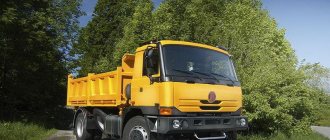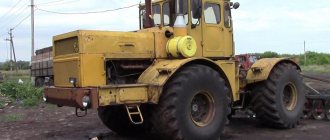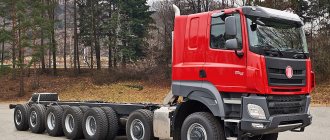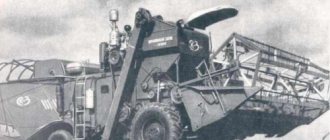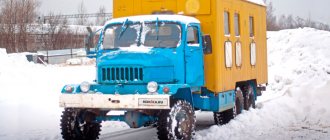Mikhail Sokolov, photo from the archives of E. Kochnev, A. Novikov, S. Andreev, L. Suslavichius, J. Arbugin, V. Baranov and the author
A whole book, and even more than one, could be written about this outstanding and legendary Czechoslovakian car. One of the brightest pages, undoubtedly, will be the story of the conquest of the vast and mostly harsh expanses of the USSR with this technique.
There would be no happiness...
In October 1938, after the annexation of Czechoslovakia, the company Ringhoffer-Tatra Werke AG, by that time part of the German concern Ringhoffer, switched to producing engines for tanks, light army all-terrain vehicles, trucks and SWS wheeled-tracked armored personnel carriers for the Wehrmacht.
But the most significant achievement of that time was the original and unique design of Tatra trucks: air-cooled engines, a central supporting pipe of the backbone frame, independent wheel suspension and excellent off-road capability. The Wehrmacht did not have anything like that in the class of heavy vehicles at that time, so already in 1939 the production of the 3-axle 6.5-ton Tatra 81 (6x4) truck was launched. And although it itself did not become widespread (less than 200 units were produced), at the end of 1940 it became the basis for the new three-axle Tatra 111 (6x6) truck with a payload of 6.35 tons, the design of which used both traditional proprietary solutions and new ones .
The so-called frame-pipe was a complex structure made up of 7 separate units. It included a front axle with suspension and steering mechanism, a front tubular insert, an additional gearbox housing, a middle insert, a middle axle, an inter-axle insert with suspension and a rear axle with a parking brake. Each part had circular flanges for connecting to each other, and all other components and assemblies were mounted on this ridge.
At that time, no one had produced such a heavy car with independent suspension. Only the tube frame made it possible to use swinging axle shafts for all axles, which ensured excellent suspension performance when driving off-road at high speeds. Another stumbling block for designers - the axle shaft hinges - was solved in the Tatra in the simplest way: when the axle shafts swung vertically, their flanges simply rolled along the gears of the GP shaft. And so that the size of the satellite flanges of both axle shafts was the same, they did a very original thing - the left wheels of the rear axles were moved 45 mm forward in relation to the right ones. The crankshaft in roller bearings and the front suspension on ¼-elliptic springs together with rods installed in a V-shape at an angle of 45° became new. The swinging axle shafts of the rear axles rested on inverted semi-elliptical springs mounted on the inter-axle insert and were held by rods, also located at 45°.
The steering also differed from the traditional one: each steering knuckle had its own longitudinal rod, and their rear ends were connected by an original transverse rod, which consisted of two parts, covering the spinal frame from above and below. It was acted upon by a lever mounted on the shaft of the “worm and pin” pair of the Ross steering mechanism.
The engine mount was also unusual: the base was an additional gearbox, and the main 4-speed gearbox along with the engine was attached to it, forming a single rigid unit, which in addition supported the front wall of the wood-metal cabin (!). The front axle was switchable, the rear differentials were equipped with locks, and the braking system was pneumatic.
During 1941, testing and fine-tuning took place, and serial production of the T-6500/111 began in 1942. The first batches went to the troops of Hungary and Romania, where at first they caused many complaints (low service life of the 210-horsepower diesel engine, breakdowns of chassis components, etc. .d.). Therefore, in March 1943, the car was improved, limiting the power to 180 hp, strengthening the rear axles and increasing the load capacity to 8–8.5 tons.
In the fall of 1943, during a reduction in the range of the Wehrmacht vehicle fleet, when the production of all other vehicles in the class of 6.5 tons and above was discontinued, the Tatras turned out to be the only heavy trucks of the Third Reich. Now they were equipped with angular plywood ersatz cabins and were sent, among other things, to the Eastern Front. A total of 1,445 Tatra 111 units were produced for the Wehrmacht.
In early May 1945, the city of Koprivnice, the birthplace of the Tatras, was liberated by the Red Army, and the factory workers presented the liberators with a gift - 10 copies of the 111s, assembled from spare parts. Apart from the trophies captured from the Germans, these were the very first Tatras in service in the Red Army. Meanwhile, the quality of workmanship of this extremely successful design was then far from ideal, therefore, with the onset of peaceful life, constant modernization took place: “Wehrmacht” ersatz cabins began to be made of steel sheets on a wooden frame, the quality and reliability of components were increased, and by 1949 everything “111s” became 10-ton.
Spar frame
This is the most common type. The frame design includes two power longitudinal beams, which are called spars. They stretch along the body and are connected by crossbars. The beams are made of steel. In order to increase twisting performance, various types of section profiles can be used.
The spars are not necessarily straight - sometimes they have both vertical and horizontal bends. They can be located either parallel to the horizontal plane or at a certain angle, which is typical for SUVs. It is also possible to have different arrangements of the cross members, through which the spars are connected. Today it is the most popular frame design, used in most trucks and SUVs.
This frame is perfect for operating the car on bad roads. It also simplifies the repair and assembly of the car. The disadvantages are that the spars take up a considerable part of the interior and somewhat complicate the landing process.
Types of spar frames
Spar X-shaped
An X-shaped frame is one of the types of spar frames. The peculiarity of its design is that the spars at the front and rear are spread apart, and in the center they are brought together as much as possible. This type is similar in appearance to the “X” beech, which is the reason for its name.
Peripheral
It is a type of spar frames. This type began to be actively used on large European-made passenger cars and “dreadnoughts” from the USA in the 60s. In such frames, the spars are located so widely that during the installation of the body they are located at the sills. This allows the floor level to be significantly lowered, while at the same time reducing the immediate height of the machine.
An important advantage of such a machine is its maximum adaptability to side impacts. However, there is a significant drawback - the frame cannot withstand significant loads, so the car body must have the necessary strength and rigidity
And again to the East
Official deliveries to the USSR of the only imported Tatra 111 truck began in 1945 and continued until 1955. The result of its tests at NAMI were very positive reviews and recommendations for further purchase. By 1949, there were already 440 Tatra-111 trucks in the Union. It would seem not much, but each Tatra, working with one or more trailers, replaced a good dozen “lawns” and ZISs. In addition, these most powerful, cross-country and reliable cars at that time worked in extremely difficult conditions - on the off-road roads of the North and Siberia, where other cars were simply powerless. In addition, the Tatras had another undeniable advantage - an air-cooled diesel engine, which cannot be defrosted and is easier to maintain.
So, after a short time, the Tatra 111 from the harsh realities of the Second World War found itself in the no less harsh conditions of Stalin’s camps. No, of course, it was not prisoners who worked for them, but civilian drivers, but the operation of the early T-111s in the USSR took place in the very heart of the Gulag, of which a lot of evidence has been preserved:
“On the Kolyma Highway, past the transfer point, trucks rushed merrily and quickly into the depths of Kolyma. These were our three-ton ZISs and even larger, more powerful vehicles, clearly not ours, but not American either. Later it turned out: these are Czechoslovak “Tatras” (from the autobiographical story by A. Zhigulin “Black Stones.” Kolyma Territory, autumn 1951).
In addition to Siberia, the largest batch of early Tatra 111S1 dump trucks was sent to the construction of the Volga-Don canal (hundreds of Tatras worked there). Alas, their fate was sad: inept operation and ruthless overloading turned brand new dump trucks into scrap metal in a matter of months.
By the way, in the Soviet press of that time only the car was covered (as one of the successes of the Czech automobile industry), but almost not a word was said about its purchases and work in our country. Another sign of the era: imports (like the Austrian OAFs a little later) were not advertised. At first this was successful, since until 1952 the Tatra 111 was assembled only in small batches, most of which went to the USSR, and the rest mainly to the army of the Czechoslovak Socialist Republic. However, by the mid-1950s, about 2000 Tatras were already operating in Yakutia, the Magadan and Kemerovo regions, the Urals and Kazakhstan.
Over time, the design of the engine and other components of the Tatra 111 changed. In the early 1950s, they began to be equipped with new, more massive and forward bumpers, and from mid-1953, the Tatra 111R model was produced with a new all-metal cabin, a shortened side platform and a modernized 111A diesel engine. (by the way, that cabin was created for the two-axle Tatra 128 truck, and only then fixed on the later “111s”). Instead of the previous platform footboards, the Tatra 111R used simplified stepladder footboards, however, as they were less convenient, drivers in the USSR often converted them to the old ones.
According to our operators, the design of the T-111 was well suited to the specifics of northern conditions - in winter it did not need water, and in the heat there was no need to worry about the radiator boiling. The Tatras handled their duties in the European part of the USSR easily. Conditions were much more difficult in the North and Siberia, where in winter their engines were not turned off for many days in a row, and there was no technical service for 2000 km or more. Here, even on the 111s, some parts began to wear out prematurely and break. To solve these problems, direct connections were established with, where wishes and complaints were addressed, and specialized maintenance and repair bases were created locally, where specialists from Czechoslovakia came to train our mechanics.
Cabin of the Tatra-815 dump truck
The Tatra-815 driver's workplace is equipped with a pneumatic seat, which can be easily adjusted to suit your anthropometric characteristics. All controls are within reach. The level of vibration and noise in the cabin is kept to a minimum, which has a positive effect on comfort.
The relatively small dimensions of the car and the cabin provide the driver with the opportunity to monitor the surrounding space without any problems, not only at the front, but also on both sides, and even behind the truck. Even if a trailer is attached to the Tatra-815 truck, the view is not limited.
The speedometer on the central part of the dashboard deserves special attention. It was combined in an original way with the dial of a mechanical watch, on which, admittedly, the time is not very visible. But this is not their main highlight. This watch must be wound like any other mechanical watch, by folding down the speedometer!
Another feature of the Tatra-815 cabin is the canister at the passenger’s feet. Which is not a canister at all, but a windshield washer reservoir. Its contents will not freeze in the cabin, so the Czechs decided to place the tank here.
The dump truck is distinguished by the ability to install different cab options. This can be a basic version, or a special extended one, which has a small space behind the driver's seat, suitable for organizing a rest area.
In addition, it is possible to purchase a Tatry-815 dump truck with a dual four-door cab, which makes it possible to transport 6 crew members at a time. The Czech plant also produces special low-profile cabins used in vehicles on which truck cranes are installed. Behind the cabin is a tilting mechanism. With its help, you can also remove the spare tire from behind the cab.
On modern versions of Tatra-815 dump trucks, air conditioning is installed in the cab. Of course, in terms of comfort and ergonomics, there is no point in comparing the Tatra-815 cabin with modern German-made cars. But compared to the KamAZ trucks of previous years, the Tatra is, of course, much more comfortable. There are practically no vibrations in its cabin, there is no engine growl, the brakes work adequately, without delays typical of the pneumatic systems of older dump trucks.
In a harsh land
In the difficult conditions of Yakutia and the Magadan region, where the driver on the road could only rely on himself and the endurance of his Tatra, before putting him behind the wheel, they were trained for a whole year on the device of the Tatra 111. Only after working as a mechanic and having learned how to repair it well, the drivers were allowed on long-distance flights.
In February 1958, Yakut drivers Gerasimenko and Isankulov were among the first lucky ones who drew lots for the right to drive new Tatra 111S1 dump trucks along the thousand-kilometer Osetrovo-Kirensk-Mukhtuya-Mirny highway. 2 years later, at a meeting with the correspondent of the Czech telegraph agency Z. Nogach, they gave a qualified description of these trucks:
“Tatras” are wonderful cars with good engines, high cross-country ability and a large load capacity. It is also remarkable that they have a 3-sided unloading of the body, which is especially valuable in our conditions, where there is not always enough space for unloading. However, designers need to pay attention to the production of stronger springs. In addition, the nylon “stockings” put on the rear axles cannot withstand our frosts; the leather “stockings” should have been preserved, as was the case on the first production cars.”
On the “111s” of that time, the bridge casings that held the lubricant, the so-called “nylons,” really turned out to be unstable to our frosts. Sometimes they broke down on the first voyage. Our drivers usually installed a two-layer oiled tarpaulin instead.
Much has been done to increase the load-carrying capacity of the machines. On their own, drivers and mechanics equipped biaxial and single-axle trailers (30 pieces were made), which then made it possible to carry cargo 1.5–2 times more than usual. Soon it became known about the initiative of another driver of the Mukhtuya motor depot. Returning from the flight, the driver of the Tatra, M. Khaimin, came to the management office and wrote an undertaking to make 6 flights to Osetrovo, i.e. twice the norm. Regarding the car, Khaimin said this:
“As the first days of work have shown, the Tatras, despite their bulkiness, are very obedient to the steering wheel, successfully overcome road obstacles and carry a large load. Therefore, in March, before the onset of the thaw, I decided to make at least six trips in my car to Osetrovo and back, and I urge other Tatra drivers to do the same.
By the way, already in 1961, employees of the Mukhtuyskaya motor depot received a Tatra 111 with a powerful Austrian-made refrigerator as a gift. Designed for 13 tons of products, it has become simply irreplaceable in the summer. An experienced driver, Viktor Baranov, was assigned to drive this Tatra.
At the beginning of 1959, the Artyk motor depot also received a portion of the long-awaited “111s”; 50 cars arrived at the Bolshoy Never station, from where they left for Aldan. Here two tank trucks with fuel were already waiting for them. It was decided to drive the Tatras in separate units of 5 vehicles, each of them carrying 6 tons of cargo. Along the way, at intervals of 200 km, the oil on the Tatras was changed and the filters were washed. A day later, the first convoy reached Yakutsk, covering 1,300 kilometers, 8 vehicles delivered trolleys, a transformer and other equipment for Dzhebariki-Khaya, and they also carried a power plant and a supply of tires for their motor depot “111th”. Then 3 cars left for Ust-Nera.
By that time, Artyk already had four Tatras, which the drivers spoke very highly of. Each could pull two trailers, and the total weight of the cargo reached 30–50 tons. And although with such an excess standard they moved at a low speed, they still got a solid gain in ton-kilometers. The winter journey from Yakutsk to Magadan at an average speed of 25 km/h took up to 20 days, but despite working with overvoltage, the 111s rarely failed.
Accepting the new Tatra, the driver of the Artyk car depot V. Belkin thought: “Is it possible to operate it, extending the overhaul intervals, like on domestic cars?” A diesel heavy truck was new to him. To begin with, he decided to understand what load the machine experiences in each mode. Gradually, skills were developed: if possible, do not put a load on the engine at low speeds, avoid jerking on climbs and when switching from high to low gear, in no case “tear” when leaving difficult places, smoothly overcoming bumpy areas.
The T-111 diesel engine had a main fine oil filter, which was periodically turned by a drive through rods from the clutch pedal. Belkin did not particularly trust this device, since during operation wear appeared in the hinges and when the clutch was not fully depressed, the filter core did not rotate, and the filter eventually became so clogged that it prevented lubrication. Therefore, every time the hood was raised, the driver did not forget to turn the core until lightness appeared. In addition, Belkin and his replacement V. Bakhmatsky installed an additional fuel filter using a mesh element from a decommissioned Lend-Lease Diamond T-980.
Under these conditions, the front drive axle of the Tatra was engaged almost all the time, except for areas where the car was free rolling. Its constant use was considered normal if it was turned on without clamping on the go. But it was impossible to allow excessive replenishment of lubricant in the hubs in order to preserve the seals and their tightness. At the same time, practice has shown the possibility of increasing the service life of both rear axles.
The 111th, on which Belkin worked, covered 96,500 km before the engine was overhauled (with only one replacement of the piston rings). The front springs were changed only once, and the batteries and brake pads were changed once. At the same time, more than 140,000 rubles were saved on repairs. Further experience showed that the Tatra, paired with an 8-ton trailer, could travel up to 150,000 km without major repairs and disassembly of units.
By the mid-1960s, the number of track repair and rest areas on Yakut highways increased, which made it possible to limit the time spent behind the wheel to 10–11 hours. There is a known case when a Tatra fell through the ice. After some time, the truck was lifted (that is, cut out of the ice), after which the engine was started, and the car drove off again.
Cost of "Tatra-815"
New Tatra trucks are currently presented on the Russian market; there are dealership centers in a number of Russian cities. The price of the new Tatra-815 dump truck starts at 9,800,000 rubles. The “successors” of the Tatra-815, the Tatra Phoenix dump trucks, are even more expensive – from 15 million rubles. Therefore, the prospects for Tatra in the new car segment in our market are very modest.
Representative of the modern Tatra Phoenix family.
There are a large number of used Tatra-815 dump trucks on the secondary car market, given their widespread use in the Soviet Union. For cars of this brand from the 80s they ask for 200-300 thousand rubles; 90s - 500-800 thousand rubles, 2000s - from 1.5 to 6 million rubles (6x6).
So, Tatra-815 was and remains the most unique heavy dump truck of its kind in the world. Of course, the machine’s development engineers – citizens of socialist Czechoslovakia – cannot be suspected of marketing tricks: all technological solutions on the Tatra-815 are quite real, not “advertising”, and are subject to pure pragmatics. And we can conclude that they have successfully passed the test of time, because the Tatra-815 dump truck is celebrating its 35th anniversary on the assembly line.
Modifications
In addition to flatbed and dump trucks, other versions of the T-111 were produced and supplied to the USSR in small quantities: Tatra 147DC-5 short-wheelbase mining dump trucks with bucket-type bodies, tanks, vans with various equipment, hydraulic truck cranes HOJ, HSC-4 and HSC-5, excavators D-030 and D-031, drilling rigs, asphalt distributors, etc. They were equipped only with all-metal cabins.
During operation in the USSR, the T-111 was also equipped with many domestic superstructures: vans, tanks, etc. The T-111R was also tried as a tractor for a mountain logging road train. In November–December 1961, the laboratory of mountain forest transport of the Caucasian branch of the Central Research Institute of Mechanism conducted comparative tests of the MAZ-501 and T-111 timber trucks with two-axle flaps 2-Р-15Т and the timber truck Praga-V3S with a single-axle flap 1-Р-8Тм (both mountain openings equipped with brakes). The machines were used in the Goryache-Klyuchevsky timber industry enterprise to remove logs along a dirt road with steep ascents, descents and turns during the period of daily rains and night frosts. “Tatra” showed the best results: the highest trip load (22.4 m3), the highest technical speed (29.5 km/h), and its hourly transport work was 85% higher than that of the domestic MAZ-501. And this despite the fact that the fuel consumption of the Tatra was 40% less than that of the MAZ, and only slightly higher than the consumption of the lighter Prague. The commission’s conclusion read: “Test data gives grounds to strongly recommend the use of heavy-duty Tatra tractors with three drive axles and a 180 hp engine for timber removal in mountainous conditions. and more".
From 1955 to 1970, based on the T-111, a special heavy ballast tractor Tatra 141 was manufactured for towing trailers weighing up to 100 tons, at that time the only vehicle of this type in the entire socialist camp. Produced in a quantity of 5,000 copies, it featured a double 7-seater cabin on a wooden frame, a short wheelbase, installation of final planetary gearboxes and all differential locks. The maximum speed of the T-141 did not exceed 45 km/h.
The modernized basic version 111R was produced until the entire model range was replaced by the new Tatra 138 family in October 1962. In total, since May 1945, about 33.5 thousand different versions of the Tatra 111 came out of the plant’s workshops, of which almost 15 thousand were lost for export to 58 countries, but more than half - 8290 units - went to the USSR.
Production
The Tatra 111 was produced for 20 years, with approximately 34,000 units built. The T111 engine was widely used in various vehicles such as heavy-duty tractors. T141, M 131 railcar, airport tugs and pontoon bridges used by the army. The engine was also "halved" to create a matching 6-cylinder variant for the Praga V3S 6x6 light military truck and the civilian Praga S5T light truck. Based on the T111 V12 engine, a V8 version was created for the T128 Four-wheel drive truck for the Czechoslovak Armed Forces, constructed mainly from T111 parts. T111's main product line includes flatbeds, dump trucks, tanks and cranes.
- Models
| T111 R - Platform |
| T111 NR - Onboard winch driven by auxiliary gearbox |
| T111 N Special - Platform with folding sides, winch military glasses |
| T111 S – Three-sided dump truck with wooden sides |
| T111 S2 - Heavy Duty All Steel 3-Way Dump Truck |
| T111 C - Tanker |
| T111 D - chassis for coachbuilders |
As the years pass
Back in the 1970s, the classic appearance of the Tatra-111 was found on the roads of the entire USSR from Western Ukraine to the Far East, from the Far North to Central Asia. But time passed, the cars wore out, were written off and gradually faded into oblivion, being replaced by new equipment, including the Tatras of subsequent models.
Some copies of the “111s” used in the USSR ended up in domestic films: “Amphibian Man” (1961), “Stitches-Paths” (1963), “An Incident That Nobody Noticed” (1967) .), “Nyurkina’s Life” (1970), etc. And taking advantage of the fact that early versions of the vehicle were supplied to the Wehrmacht, they were often filmed as German trucks in films about the war: “The Living and the Dead” (1964) , “One Chance in a Thousand” (1967), “Until Dawn” (1974), etc.
To this day, only one specimen has survived in Russia, brought to the Magadan region in the 1950s. In 1973, the team of the Berelekh motor depot No. 5 installed one of the last remaining Tatra 111S2 on a pedestal. This monument, erected near the repair shop, was a tribute to the working machine and a symbol of Soviet-Czechoslovak cooperation. But alas... With the collapse of the USSR, everything fell into disrepair, including the motor depot, and the Tatra was abandoned. Having stood in the open air for almost 40 years, the legendary car now evokes only a burning feeling of pity and shame. Shame, because in the Czech Republic and Slovakia our vintage cars are in disproportionately better conditions. Will anyone take up the task of saving this unique example of a world-famous machine, even by design recognized as one of the best developments, where the form most closely matches the purpose?.. It is unknown. But I still want to believe...
Technical characteristics of the main Tatra 111 variants supplied to the USSR
| Tatra T-8000/111 | Tatra 111S1 (Tatra 111S2 and S3) | Tatra 111R | |
| Type | Onboard | Dump truck with unloading on 3 sides (dump truck with unloading to the rear) | Onboard |
| Years of manufacture | 1943–1949 | 1946–1953 (1952–1962) | 1953–1962 |
| Load capacity, kg | 8000–8500 | 10 240 | 10 000 |
| Weight of towed trailer, kg | 16 000 | – | 22 000 |
| Curb weight, kg | 8350 | 9250 (9260) | 8600 |
| Overall dimensions, mm | 8550x2500x3100 | 8320x2500x2504 (7430x2500x2570) | 8300x2500x2880 |
| Wheelbase, mm | 4175+1220 | 4175+1220 (3825+1220) | 4175+1220 |
| Ground clearance, mm | 270 | 290 | |
Engine:
| T103 (V850), diesel, V-12 14 825 180 at 1800 min-1 | T111 (V950), diesel, V-12 14 825 180 at 1800 min-1 | |
| Platform: platform dimensions, mm | Wooden 5500x2350x600 | Wooden (metal) 4740x2350x400 (3940x2340x480) | Wooden 5000x2340x500 |
| Wheels | Disc, rim 7.33V-20 | ||
| Tire size | 10,50-20 (270-20) | 11,00-20 | |
| Maximum speed from full. load, km/h | 60 | 61,5 | 62 |
| Fuel consumption, l/100 km | 38 | 35 | 34 |
Features of operation
The technology under consideration has undoubted advantages in terms of ease of use.
The small overall dimensions allow the driver to easily see the entire space behind the truck, even if a trailer is attached to it. The large windshield allows for a clear view of the area in front of the cabin.
The cabin itself is equipped with a pneumatic driver's seat; it can be very easily and quickly adjusted to a person with any anthropometric data.
All controls are within easy reach; there is no need to reach far to perform any actions (turning on the lights, turn signals).
The level of vibration and noise in the cabin is kept to a minimum, which has a positive effect on comfort. While driving, the driver experiences minimal fatigue. The latest versions of the Tatra 815 are equipped with air conditioning and a very powerful diesel stove.
Tatra 815 trucks have outstanding performance characteristics and also have many other advantages, which makes their use convenient and economically feasible.
If the operating conditions are observed and scheduled maintenance of components requiring this is carried out, then the car will serve its owner for many decades.
After reading the technical characteristics of the dump truck, we suggest watching a video from which you will learn under what conditions the Tatra 815 can be used:
The new Tatra-138 leaves the assembly line in Kopřivnice
Over 17 years, Czechoslovak workers assembled almost 33 thousand well-proven trucks.
The time has come for modernization and in 1962 the Tatra-138 took over the baton. It differed from its predecessor in the modular arrangement of units. This was done to unify the production of modifications with different wheelbases. Otherwise, all the previous merits were preserved: ✅ backbone frame, allowing movement even without one front wheel ✅ high strength of the frame to various bends ✅ well-protected transmission elements ✅ engine mounted on four supports
Traditionally, trucks operated in the harsh conditions of the north of the country. They also took part in the construction of the Bratsk Hydroelectric Power Station and many Soviet cities located above the Arctic Circle. In addition to rave reviews about them, there were also some complaints. The vulnerability of the protective covers of the axle shafts, the questionable reliability of the suspension torsion bars - all this required additional research and testing. So some design changes were made:
✅ additional thermal insulation of the cabin ✅ autonomous heater running on oil fuel ✅ heating of the truck body with exhaust gases
Successful independent development
TATRA has made significant progress in developing its own direct air-cooled engines:
- First of all, it is the first and only company in the world to create a V8 diesel engine with a turbocharger, intercooler and mechanical fuel pump that meets Euro 3 environmental requirements.
- Later, in 2006, the engine was equipped with SCR technology (exhaust gas purification by injection of AdBlue - 32.5% urea solution), which brought it into compliance with Euro 4 and Euro 5 specifications (in 2008). This step was also a first in global auto production.
About the manufacturer
The only concern that has managed to preserve its 170-year history and production home is Tatra Trucks. The company has remained faithful to the Czech design school and continues to successfully develop and disseminate its ideas.
Five time-tested company differences:
- The only old-timer in the automobile production of Central Europe and the second oldest in the whole world.
- Her firstborn is a car born in 1897 and a truck born in 1898.
- – a unique direct air-cooled diesel engine.
- Tatra vehicles are adapted to work in extremely difficult conditions and go where no one else can.
- Unique author's design solutions.
Interesting fact! In 1986, the company's management, for the purpose of marketing promotion, decided to participate in the Tatra team in the Dakar Rally. Two T815 cars passed the track. Having gained experience in the increasingly popular race, Karel Loprais's team became the winner for the first time in 1988. After this start, they managed to win these races five more times.
Detailed information is visible in the video:
The path to creating a car
There is no denying the fact that Fischer was a visionary. He was the man who played an important role in the creation of the first internal combustion engine car in Austria-Hungary and Central Europe.
Perhaps he was looking for use for the skills of carriage makers, drapers and other specialists who no longer had a place in the company due to the fall in demand for carriages and chaises. Perhaps he came up with the idea of producing cars after seeing photographs of a “horseless carriage” published in La Locomotion Automobile (binders of publications from 1895 to 1898 are stored in the company’s archives). Most likely, Fischer thought like this: “We can produce carriages and chaises, and they differ from those in the photographs in a few minor details: you just need to add an engine, transmission and steering wheel - and you have a car. One of these "minor parts" - the engine - can be ordered from the manufacturer. The production of other parts and assembly can be organized in Kopřivnice.” The idea was brilliant in its simplicity!
At this moment, Baron Theodor von Liebig, owner of a factory in the city of Liberec (Reichenberg), appears on the scene. It was solely thanks to his friendship with Karl Benz, the creator of the internal combustion engine car, that the latter agreed to donate one of the first two-cylinder engines created in 1897 to Kopřivnice, as well as to undertake a regular supply of engines for the first cars of the Kopřivnice factory.
